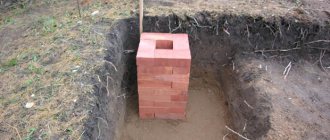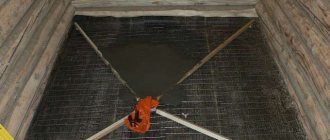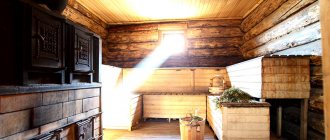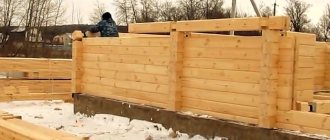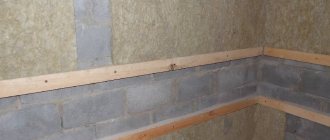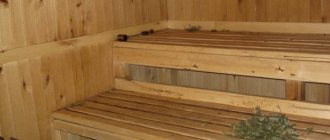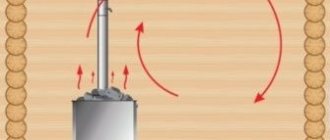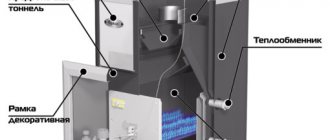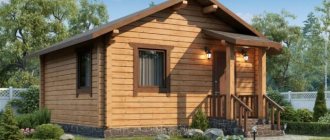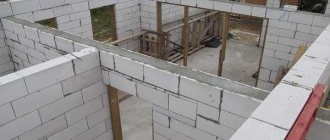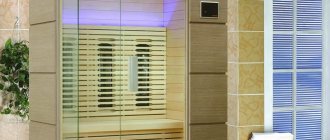The largest warehouse of larch products in Moscow. All varieties, more than 1000 m3 of products in stock.
+7 +7 Call daily Mon-Fri 9:00 - 18:00 Sat 09:00 - 15:00 Sun.
Day off More details
The Russian bathhouse is a place of healing and relaxation for body and soul. And it is not surprising that it was built from wooden beams, choosing coniferous trees. This is the most useful, durable and beautiful material. Of course, a species such as larch is distinguished by all these qualities. The tree grows in Siberia and the Far East, is extremely common and is the best material for finishing a bathhouse.
How to compare materials correctly
Of course, there are financial resources and time, quite realistically, and universal solutions. For example, build a log bathhouse from cedar, preferably Canadian, and use African oak to decorate the steam room. Even with a successful design, steaming in such a bathhouse is not much better or more comfortable than in a regular one, but it will last ten times longer than a log house made of aspen or even larch. But such a box will be very expensive. Perhaps, with the money spent on arranging such a bathhouse, it would be better to build four full-fledged wooden saunas made of cedar pine and linden.
Wood used in bath construction is divided into three categories:
- Finishing material for steam room walls, shelves, bath accessories;
- Material for arranging the wettest parts of the bathhouse;
- Wall block or timber.
This division did not arise by chance; as a rule, a certain type of wood performs best under certain conditions. For example, oak or larch are better suited than pine or alder for a bathhouse when it comes to constructing a log house or building frame. At the same time, heavy oak, acacia or birch are never used for wall decoration of the steam room. The denser the wood, the more it burns the skin, and birch board also produces bitterness.
Drilling
To drill a hole, special equipment is used, since it is necessary to drill it 1.5 times, or even more, than the width of the log.
The diameter of the log must be at least 20 cm. Accordingly, if the diameter of the trunk is 20 cm, then the diameter of the recess must be at least 30 cm. If you wish, you can dig the ground yourself. To do this, you need a drill with a diameter of 20 cm, with which you dig a hole, then for expansion you use a drill with a diameter of 30 cm. It will not be possible to immediately dig a hole of 30 cm with a drill using physical force. To make work easier, add water.
What is better to pay attention to
When choosing a material, in addition to price and tactile perception of the wood surface when touched, you need to pay attention to two important points:
- Wood workability;
- Resistance of the material to moisture and high temperature;
- Decorative qualities and smell.
All three categories have their leaders and outsiders. For example, linden and aspen have the best workability, cedar and larch are considered to be moisture-resistant, alder and abash are considered the most beautiful and comfortable to touch.
Of course, there are universal types of wood, the qualities of which are no better than those of the leaders, but they can be used to a certain extent for any parts of the bathhouse. Such materials include aspen, larch and cedar.
Covering the steam room with larch
When selecting cladding for a bathhouse, it is important to remember that you need to choose one material to finish all the surfaces inside. If you want to cover the steam room with larch clapboard, then the shelves, benches and other interior items must be made from it. You will get a uniform style and overall wood moisture levels.
The only part of the finishing that does not have to be made of larch is the floor. Near the floor, the temperature does not rise above 30-35 degrees, it does not take on extreme heat. However, for the integrity of the design, choose larch for the floor as well.
It is better to treat the lining before installation to protect the material from darkening. As usual, the arrangement begins with the frame - the sheathing on which the lining will be attached. Bars or boards are suitable for the frame. The fasteners are inserted hidden. The lining is installed using the same technology as in other rooms, leveled and fastened tightly to each other.
Your steam room will last for decades without losing its appearance.
Aspen bathhouse, pros and cons
At first glance, aspen is no better than cedar or beautiful alder. You can understand the choice at least by the fact that in the old days most of the log baths were built from specially selected aspen logs. In modern comfortable steam rooms, aspen is used in places where it would be better to lay plastic or expensive mahogany.
At the same time, according to reviews, a log house made of aspen for a bathhouse could withstand, without any treatment, in damp, swampy areas where only larch and oak can withstand.
For your information! Aspen is a capricious material that requires a special approach and attention. Especially when harvesting logs and preparing them for placement in a bathhouse box.
But with the right approach to the material, in the hands of an experienced craftsman, it is difficult to find better aspen for building a bathhouse.
How is aspen better than other species in a bathhouse?
The tree grows on waterlogged soil, so the structure of the material is thin intertwined fibers, quite dense and viscous. To build a log bathhouse, they use trunks of forty-year-old trees, carefully selected and discarded. After winter drying, the logs are sawn and assembled into a log house, and it is best to build quickly, joining the crowns at the corners “into a paw.” Very quickly, an aspen log house for a bathhouse shrinks, the aspen wood becomes very compacted and hardens, and cutting it becomes very difficult.
The advantages of aspen include the following qualities:
- Fresh and dried wood is quite soft and pliable due to high humidity. In this state, aspen, like linden, can be cut with a knife in any direction of the grain;
- Aspen is not afraid of heat shock, high temperature, and humidity. Wood is better perceived when touched by hand than any other material, the only exceptions being mahogany or African oak;
- Properly dried, treated and aged wood is not afraid of putrefactive bacteria, fungus and even some wood insects.
For your information! At the same time, aspen has quite high strength; joists, ceilings, frames of door and window openings are made from boards and timber.
Often, an aspen log house is not even lined with additional finishing from the inside. Moreover, the craftsmen claim that it is better to leave the aspen crowns as they are, open. It is believed that steamed aspen releases special substances that are good for toning the breath and skin. The popularity of aspen baths is so great that some extraordinary medicinal properties are attributed to its effects, despite the fact that aspen wood does not have any phytoncides or resins, like conifers.
Interior finishing options
If, in order to save money, you leave the log house unsheathed, you will have to come to terms with the fact that coniferous wood will release resin for several years. In such conditions, a good solution would be linden or aspen.
The floor in the bathhouse deserves special attention. Larch is perfect for forming flooring - in this aspect it is characterized by increased wear resistance and durability.
It is important that such wood does not react to temperature changes and does not rot at constantly high humidity.
Larch is famous for its interesting decorative properties - it has a rich natural color palette and beautiful texture.
What is inconvenient about aspen for arranging a bathhouse?
The main disadvantage of aspen wood is the difficulty in selecting quality material. Aspen, like no other material, must be carefully selected and discarded. The better the screening, the longer the bath lasts. If you come across a log with foulbrood, it can infect the entire structure before the aspen becomes dense and insensitive to rot.
The second disadvantage is considered to be the darkening of the surface under the influence of air and sunlight. To return an aspen bathhouse to its original light appearance, it is best to sand the surface or sandblast it.
Installation
Installation of deck boards for showers and steam rooms is approximately the same. The point is that there is good ventilation between the board and the concrete floor and the moisture evaporates quickly. There are some rules for installing decking boards in steam rooms and showers:
1. Try to leave a large gap between the boards, approximately 5 to 20 mm. This will make it easier for the boards and joists to ventilate and dry.
2. The concrete floor on which the board will be installed must have a good slope for water drainage.
3. The stove must be below the level of the decking board. This is necessary for uniform heating of the entire space, including under the board.
4. The boards should be laid in the opposite direction from the direction of the annual rings. This is easy to do by looking at the end of the board. The fact is that over time the board turns out like a boat, which makes it difficult to remove water from the surface of the board. Such a board quickly cracks and becomes unusable. if you lay it correctly, then the water, on the contrary, will quickly drain from it.
5. Divide the decking into small sections. This is necessary in order to remove the flooring at any time and clean the concrete floor from dirt and grease.
6. Treat your joists with waste boiling machine oil. This is a very effective old-fashioned method that will preserve your lags for a long time.
Sauna made of aspen and linden
Both materials are considered the most affordable and in demand for interior decoration of saunas, steam rooms and even dressing rooms. Shelves and benches are most often made from linden, since in a hot steam room a soft linden bench always feels cooler to the touch than aspen. Especially after several years of service in a humid environment.
How to distinguish linden from aspen. The question is simple, but important when it is necessary not to confuse the material used for lining the steam room and for the door blocks in the bathhouse. Freshly planed slats and boards made of linden and aspen are practically indistinguishable in color and texture. Aspen has a more pronounced fiber pattern and a slightly lighter, even grayish surface tone.
Linden can be distinguished by its characteristic smell; sometimes craftsmen check the maturity and dryness of the material with a drop of honey. On aspen it will spread and be absorbed, but on linden it will remain a compact droplet. Of course, linden is only suitable for cladding and furniture of a steam room; it makes no sense to build a log house or a bathhouse frame from it.
Sometimes bathhouse customers wonder what is better, aspen or linden in the steam room. Both materials are almost equivalent, both darken over time from water and dirt. Only linden absorbs everything that is washed off, while aspen simply oxidizes and becomes stained. In both cases, texture and color can be restored.
If you have to choose between linden and aspen, it is better to remember the unique properties of aspen wood to kill pathogens. In the old days, it was used to make upholstery and tubs for drinking water, which never became cloudy and bloomed.
Features of the preparatory stage
Before you begin directly assembling the log structure, you need to decide on the layout of the future facility and pre-process the material.
Possibilities of bath planning
The classic configuration of a bathhouse involves the arrangement of three internal zones: a steam room, a washing area and a dressing room. In some cases, in order to save money, homeowners combine a washing room with a dressing room, but in practice this option is very inconvenient. These rooms must be adjacent so that users move from the dressing room to the washing room and then go to the steam room.
Usually the washing room and the dressing room are made the same in size, and when calculating the square footage of the steam room, they take into account the number of people this room should serve at the same time. The dressing room is designed so that it can fully fulfill the task of a rest room.
Log processing
All workpieces must be hewn using the “staple” method in order to minimize the difference between them. In the case when thin logs are used as the main material, you need to decide in advance what and how the log house will be additionally insulated.
The wood is cut in accordance with the future length of the wall; it is necessary to provide allowances, thanks to which protruding corners will be formed (these areas protrude beyond the walls). In the case of short logs, when their length is not enough to create normal allowances, the ends of the workpieces are sawed at right angles - this way they can be joined without the need to remove the remainder.
The procedure for marking diameters can create difficulties. The possibility of arranging the ridges and edges of logs with the required slope parameters depends on the correctness of this manipulation.
Alder sauna
The very beautiful and unusual texture can vary from pinkish-yellow to rich, almost orange colors and shades. Alder, along with linden and aspen, is one of the three materials most often used for finishing a steam room in a bathhouse. According to reviews, alder for a bath remains a rather complex material:
- The strength of the wood is low, but there are no cracks or chips in the finishing of the bathhouse;
- It easily absorbs water, but when stained for a long time in water, it simply acquires metallic strength, like stained oak;
- It does not tolerate overheating well, but the smell of a smoldering splinter or heated wood is considered very pleasant, even refined.
Freshly cut alder is almost white, like poplar or aspen. After drying in air, the surface becomes orange-red; after treatment with an ammonia solution, it acquires a very beautiful texture and color. Alder veneer is used in bathhouses as a way to imitate mahogany. In decorative terms, a properly processed alder surface looks better than natural mahogany, chestnut or walnut.
If you need to provide a pronounced therapeutic effect, then black alder is better suited for a bath. It, like aspen, releases a huge amount of volatile substances that have a beneficial effect on the upper respiratory tract.
Larch lining is a popular, relatively inexpensive and easy-to-install material for decorating both the external and internal surfaces of premises for various purposes - walls, ceilings, balconies and loggias, dressing rooms, concert halls... (Turnkey interior finishing of a bathhouse ). The division of lining into standard and eurolining is determined by the requirements of the relevant standards for the production of cladding boards. The domestic production standard is GOST 8242-88, the European standard is DIN 68126.
In many cases, larch lining is purchased for a bathhouse, because in addition to aesthetic characteristics, it is characterized by high strength, as well as resistance to moisture ( Finishing a steam room in a bathhouse ). In the modern world there is an increase in production volumes of products from this type of wood. Professional designers from many countries widely use such lumber in their creations, thanks to which they can bring interesting ideas to life. Nowadays, it is difficult to find another natural material for cladding any surfaces that meets all the basic requirements than hardwood lining. It is perfect for exterior and interior decoration of verandas, gazebos, country houses and other buildings. Experts in the construction field recommend using panels made of such wood for lining washing compartments, because this species is not afraid of moisture and water. The cost of such products can vary significantly depending on the variety.
Properties of wood. Features of larch lining
In Russia, the tree is very widespread, although the main habitat is Siberia and the Far East. The tree is a coniferous tree, but in the winter it sheds its needles, just like deciduous trees, which is why it got its name. According to scientists, the genus of such a tree includes more than ten separate species that have certain traits. In fact, larch is a sound species, and therefore has a unique color range. There are 10-15 types of wood. Depending on the living conditions, larch can grow into a heroic tree taller than 50 m - European deciduous, and with a trunk diameter of up to 1.6 m, and can take creeping forms. The core wood has an intense red-brown or pinkish-red color, the sapwood is narrow, brownish-white. Tree rings are very visible, which is why larch products have a distinct woody pattern. Wood is characterized by high user qualities. • Strength – compression along the fibers is 641–105 Pa, and bending is 1189–105 Pa, higher than that of oak, and at least twice as high as pine. • Density – from 0.54 g/cubic cm to 0.63 gm/cubic cm, that is, comparable to the density of oak wood. After complete drying, it is impossible to drive a nail into the product, the wood becomes so hard. • Resistance – a characteristic feature of larch is very high resistance to decay and the action of fungi. Window frames and door slopes made from it do not need to be treated with an antiseptic. Wood is used for the manufacture of underwater structures, as it is insensitive to the action of water. • Drying – due to the large difference between the degree of tangential and radial shrinkage, wood is prone to cracking. Therefore, the drying process takes a long time and must be carried out with careful adherence to rules. Otherwise the material will be destroyed. • Processing – due to its hardness and strength, wood is very difficult to process. An additional difficulty is caused by the high resin content - the tool quickly becomes oily during processing.
Advantages and disadvantages of larch lining
The material has all the qualities of wood: density, strength, hardness, beauty of shades - light yellow, golden brown, red. The lamellas do not require additional treatment with antiseptics and can be used for cladding both inside and outside the building.
However, the entire range has five distinctive features:
- Stability in humid environments, achieved due to the content of tannins and natural resins. Such products can feel good even with constant contact with water.
- High margin of safety, allowing lumber to withstand severe mechanical loads. The hardness of this species and oak is almost the same and differs within one unit on a special scale.
- The formation of a pleasant microclimate for the human body provides the opportunity to live in comfortable conditions. In winter, this type of product provides the best heat accumulation.
- Aesthetic appeal expressed in an unusual and very beautiful structure. This wood is characterized by rich shades and intricate patterns, which is confirmed in the video.
- Increased fire safety, unlike other similar materials. For example, in comparison with pine, the fire resistance of larch is twice as high. However, you should not neglect safety precautions in any case.
Types and sizes of larch lining
Extra larch lining is considered to be of the highest quality; with this class there should not be any visible defects or defects. Chips, dents and potholes are not allowed on the surface of the products. Wooden panels are selected depending on the purpose of the room in which they will be located. Below are the remaining categories of this product.
Class A larch lining
There may be light knots on the surface of the products, but their size should not exceed 15 mm in diameter. One such defect is allowed per linear meter. In addition, slight roughness, tarring, and non-through cracks extending into the end part are allowed if their length is less than 95 mm.
Class B larch lining
Products in this category may have light knots of any size, but the falling parts should not be larger than 20 mm. As for the number of such defects, one defect is allowed per linear meter. The presence of fallen rib, tobacco and rotten knots is prohibited. Dents, cuts, scuffs and the like are allowed, but with a size of no more than 15 mm.
Class C larch lining
This is the lowest category of products, so they cannot boast of quality and aesthetic characteristics. However, there is one main advantage - the price, which is noticeably lower than in the case of previous analogues. Any knots, tars, wormholes, resin pockets and other defects are allowed on the surface of the panels.
Types and profiles of larch lining
Cladding boards are available in several types. Such products are the most popular.
• Larch lining - a flat board with rounded edges and without a shelf - recesses on the tenon side. Shtil is an almost universal material, suitable for any finishing work. In the photo - Shtil cladding boards. • Softline – has rounded contours and a ridge above the tenon. • Blockhouse - imitation of rounded timber, is the most popular type of profile.
Installation of larch lining
Before you begin installing the cladding, you need to decide on its direction. This consists in the horizontal or vertical arrangement of the wood. Both methods are good, but decorating a room using only one of them is not the best idea, because the cladding will be monotonous. The fact is that horizontal installation of lining visually lengthens the walls, and vertical installation visually increases the height of the ceiling. The combined type of finishing is the most pleasant for the overall appearance. For example, horizontal installation of the lining can be used up to the waist, and vertical installation above. Thus, both effects will be used and will contribute to the greater attractiveness of the interior. The same method can be used in the external cladding of buildings. The original type of installation of wooden lining would be to use a diagonal orientation.
Installing paneling in rooms with normal humidity is primarily a matter of personal taste, but in rooms with high moisture levels, paneling placement is an important part of proper functioning.
Using the example of a bathhouse, we can examine the advantages and disadvantages of cladding rooms with high humidity. Vertical installation allows liquid to drain faster, making installation easier, faster and at a lower cost. The disadvantages are different temperatures near the floor and under the ceiling and the blocking of the possibility of ventilation by the horizontal fastening beam.
Horizontal installation of lining does not have such disadvantages, but its cost is higher, and the installation process itself is more complicated. However, using this method makes it easier to replace the various boards if they become damaged. Although, when using larch, such problems do not arise, because this type of wood is not susceptible to rotting and infection by parasites.
Frame for clapboard cladding The design of the frame, which will support the cladding, is mounted on walls and ceilings in two types: horizontal and vertical. The boards must be installed perpendicular to the frame. Materials for construction are varied - from metal to wood. Depending on the flatness of the mounting surface, the frame can be mounted directly on the wall or on installed metal or wood mounts. The most convenient hangers for mounting a frame under wooden lining are U-shaped. It is worth noting that there should be space under the structure for air circulation.
The entire process must comply with fire safety requirements, so all electrical elements (wires) must be hidden in metal pipes. This is a necessity, because wood is a flammable material.
Types of fastening lining Wooden lining is fastened in two ways - open and hidden (Methods of fastening lining). The open method involves driving a finishing nail into the body of the board, thus attaching the lining to the frame. This method is not aesthetically pleasing, because rows of caps will be visible on the surface . The hidden type uses nails, staples or clamps . Installation of wooden lining is done by driving in a rod at an angle of 45 degrees, which makes the attachment point invisible. Clamps make the installation, to some extent, like assembling a construction kit. They are attached to the frame, and the boards are inserted into the grooves.
Processing of larch lining
Despite the very high durability of the material, the lining allows for several processing methods in order to increase the decorativeness of the surface.
- Polishing is not all, but most types of wood take well and retain the polish for a long time. The resulting silky, very soft shine adds a lot to the aesthetic appeal. Looks great on flat boards - calm or standard.
- Varnishing - as a rule, colorless varnishes are used, since wood has a very rich color, and it is difficult to change it with varnish.
- Aging – or structuring. A design technique designed to increase the expressiveness of the structure.
Unlike softer types of wood, it is almost impossible to obtain textured larch lining using manual labor. It is made on special machines, where the soft top layer of wood is removed using hard metal brushes. On the surface of a structured board, the wood grain is very expressive. An interesting feature of this finishing method is that to obtain a textured surface, it is recommended to choose not the extra category, but just lower grades, since the product looks better with a large number of knots.
Using larch in the bathhouse and interior
Wooden lining is a high-quality finishing material, which today is actively used for interior work in premises for various purposes. Covering the walls of a bathhouse with wooden clapboard gives it an aesthetically attractive, decorative look. It is best to use larch lining for the interior decoration of a bathhouse. Unlike many similar materials, larch wood does not emit resins, which is especially important for bathhouses.
And the fact that it has low thermal conductivity also serves in favor of choosing this type of lining. By leaning against the wall of the bathhouse, the visitor does not risk getting burned, which is important for observing basic safety rules in bathhouses. Larch lining has a pleasant appearance. But you must take into account the fact that during use the wood may darken. And the special climatic environment of the bathhouse only contributes to this. Therefore, it is recommended to initially treat the lining with high quality using special means.
Lining made of Siberian larch is one of the most popular materials for finishing bath rooms. The interior of such a room is characterized by many aesthetic and functional indicators: o The internal space of the bathhouse retains the accumulated heat well and for a long time. o In the process of daily exposure to high temperatures and water vapor, the lining does not rot. o Long service life allows you to profitably save money on interior decoration. o The interior of the bathhouse, decorated with larch clapboards, is distinguished by its aesthetic, natural appeal and creates a special atmosphere of coziness and comfort. o It has been proven that natural wood in a bathhouse has a beneficial effect on human health and well-being. o The bathhouse does not need to be regularly treated with various chemical and biological substances to prevent harmful insects and decay processes. o Larch retains accumulated heat for a long time and releases it into the room. o Larch contains a huge amount of natural antioxidants that help stop the aging process in the body.
From all of the above, the only correct conclusion can be drawn - larch lining is ideal for arranging the interior space of a bathhouse. Larch floors have the same properties. And construct benches, backrests and other designer surfaces from solid deck boards.
Larch floor in the bathhouse
Larch produces many types of materials that can be used for flooring. Larch is the only hard coniferous species. And in terms of hardness (coefficient 3.2 on the Brinell scale), it is not inferior to beech and oak. Moreover, over time, the density and strength of the material only increases.
A tongue and groove floorboard is the most common type of wooden floor covering inside a bathhouse, house, apartment, etc. 1. Such boards have a tenon on one longitudinal side and a groove on the other. 2. Some manufacturers make compensation cuts on the back of the planks. 3. Such larch is joined to the floor closely. 4. Tongue and groove floor boards have different widths (8/20 cm), length (2/6 m) and thickness (2/4.5 cm), which must be selected based on how the covering will be laid: on joists or a subfloor .
Deck strips are a type of boards suitable for laying floors both in open spaces and inside wet rooms. As the name suggests, such lumber was previously used for cladding ship decks. Nowadays, it has also been used on land. Using deck boards, flooring is laid around pools, terraces, gazebos, verandas and balconies. Larch is ideally suited for such premises, as it practically does not absorb water, is resistant to warping and is very dense. Traditionally, smooth decking boards are not laid close to each other, but with small gaps. Deck cladding is ideal for rooms with high levels of humidity, namely for baths and saunas. It can be installed in the bathroom, sink and steam room. Sometimes this type of lumber is used as garden parquet, for making paths in a park or garden, or for lining spaces adjacent to a fountain or pool.
Deck board - this type of decking (boards intended for external coverings), unlike deck analogues, has a corrugated surface (corduroy). In all other respects, they differ little from each other. Thanks to the relief, it is difficult to slip on such a floor, even in conditions of high humidity. Therefore, many owners of their own plots choose this particular type of larch materials. It is resistant to precipitation and dampness, fits freshly and harmoniously into the interior and exterior of country houses. Such boards have two identical working edges. They have a high degree of wear resistance, not only due to the strength of larch, but also due to their large thickness.
Often, the use of floor coverings by designers in their projects in tandem “larch and floors” is associated with aesthetics, visual appeal of the natural texture of a given type of wood. Widespread use in open spaces such as verandas, gazebos, and swimming pools is explained by the resistance of decking boards to temperature changes, as well as low or high humidity. Upon request, the boards can have compensation cuts on the back side to increase the stability of the coating. It is installed with your own hands, usually on logs or a metal frame.
Important! This type of lumber is mounted with certain gaps between the boards. They have a rounded chamfer at the corners. This feature allows all dirt and water that gets on the coating to leave without obstacles. As a result, the instructions recommend it for outdoor areas, decks, paths, piers, bridges, as well as open and wet areas.
Parquet board is a modern timber material used for flooring only indoors. It differs from traditional floorboards in that it has locking elements on all sides. Therefore, they fit closely not only in length, but also in width. With a width of 7.2/14.5 cm, the planks are short in length (60/160 cm) and thick (19/21 mm). Therefore, they should only be laid on a solid subfloor. The methods for laying these coatings are the same as for traditional parquet: “staggered”, “herringbone”, etc.
Lining made of larch. Price per square meter
Larch lining is the most suitable material for installation. Despite the variety of wood types offered by craftsmen, this wood stands out for its quality and unique characteristics. Installation of larch lining guarantees the durability of both external and internal cladding. For construction work, it is necessary to choose only high-quality materials, because the durability of the work performed depends on them. Currently, euro-quality lining or eurolining is mainly used for domestic purposes. Since there is practically no lining manufactured in accordance with GOST on sale, euro-lining is often called simply lining. Currently, there are several types of lining profiles: “classical” lining or “peasant” lining; soft-line lining, the corners of which have been chamfered; Calm lining, which lacks the “shelf” characteristic of lining. The cost of the lining, which is most often used, currently starts from 380 rubles/sq.m.
Larch bathhouse
All coniferous wood species are considered to be the most suitable for the construction of walls, ceilings and floors. A larch bathhouse can be easily distinguished from a pine or cedar structure by the darker color of the wood. The cedar bathhouse photo looks light, with a yellowish tint.
Larch wood is known for its incredible resistance to decay and mold pathogens. Boards and slats can easily withstand alternating loads at high temperatures and in conditions of high humidity, so a log bathhouse made of larch turns out to be the most durable and strong of all conifers.
The construction of a bathhouse from larch, without any additional processing, has the durability and strength of modified stained aspen. Larch is best suited for sheathing insulation, joists, ceilings, wherever elements of the bath structure come into contact with moist hot steam.
The only thing in which larch loses to aspen is its tendency to form cracks, chips, and chips; when heated strongly, a resin is released that can stick to it. Therefore, it is not used on the floors and furniture of steam rooms. Larch cladding has a resinous, tart odor that never goes away, even after several years of service.
Most modern projects are bathhouses in the form of a log house made of cedar. Relatively inexpensive and accessible Siberian pine wood is considered the optimal material in terms of price and quality of construction. Unlike aspen or larch, cedar is cheaper and better processed by machine, so it has become the most popular material for baths.
The material has a large amount of resin with a pleasant smell, which is not irritating and can cause allergies. Therefore, it is best to use cedar that has been bleached with hydrogen peroxide for a steam room. A cedar steam room is inferior to an aspen room in terms of durability and rich atmosphere.
Furnace arrangement
The main attribute of the bath - the stove - is installed on a pre-prepared base. The stove foundation must have a recess of within half a meter, and a gap of at least 5 cm must be left between it and the base of the building.
As experts note, the optimal base can be rubble concrete or concrete, supplemented with roofing felt or roofing felt as waterproofing. To increase the service life of the furnace, the masonry is made of refractory, refractory brick, free of foreign inclusions and cracks. The solution is mixed using clay and sand in equal proportions.
Installation of metal components is carried out along the course of the masonry. Such parts are insulated with asbestos, leaving 5 mm as a compensation gap. In this case, the expansion of the metal due to heating will not cause deformation of the masonry.
